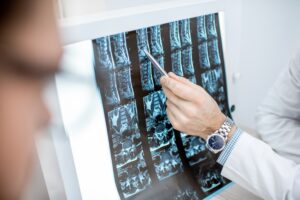Our spinal discs handle an immense amount of strain over the course of our life, and eventually all that stress can lead to a gradual breakdown in the strength and size of the discs. This is especially common in your lower back, which oftentimes handles the most stress when you’re moving or in a seated position. Oftentimes this disc breakdown is classified as degenerative disc disease, and it can lead to a range of symptoms from mild discomfort to major pain.
But what are some of the best ways to handle lumbar disc pain that is the result of natural wear and tear or injury-related degeneration? We talk about some of the ways you can manage lumbar disc discomfort in today’s blog.
Managing Lumbar Disc Pain
Because disc degeneration is unique to the individual and could be affecting any number of different spinal nerves in the area, your best bet for managing lumbar disc pain is by connecting with a spine specialist who can provide you with in-person care. They’ll be able to see exactly what you’re dealing with and develop a treatment plan tailored to your needs. With that said, don’t be surprised if they recommend a number of the following treatments:
- Exercise – Exercise is great for strengthening key areas of your spine that help to support your spinal column. If your spinal column is better supported, it means that stress can be better dispersed to other structures, taking pressure off of your spine discs. If disc pain is causing discomfort, you’ll want to steer clear of exercises that put a lot of strain on your spine, or those activities that can be quite jarring in nature. For example, running is a little more stressful on your lower spine than some other activities, like cycling, swimming or walking. Find some low-impact exercises that help to strengthen your back and body.
- Physical Therapy – Physical therapy is like exercise on steroids in that it involves targeted strengthening of specific structures. While swimming or walking may mildly help your spine while providing whole body benefits, physical therapy aims to improve the health of specific areas of your body, like your lower back. Working with a physical therapist can also ensure that you progress through PT exercises at the right speed so that you continue to improve without increasing your risk of injury because you overloaded the area. PT is also great because oftentimes you can perform exercises from the comfort of your home.
- Heat/Ice – Heat and ice are great ways to help manage some of the discomfort caused by your lumbar disc issues, but oftentimes they don’t target the underlying cause of the problem, so don’t make heat and ice your only forms of treatment. Ice can help to constrict blood vessels and limit swelling in an area that could be impeding normal movement, while heat can help to open up those blood vessels and bring healthy blood to your back, which is helpful if you’re dealing with muscle spasms or cramps in the area. Experiment with both techniques and pair them with the active treatments listed above for the greatest benefit.
- Posture Improvements – One final treatment technique that we want to spotlight is posture improvement. How you sit determines how much stress is put on your lower spine, and if you’re slouched in your seat or sitting out of a healthy alignment, your lower back may be overloaded with stress. Poor posture is one of the leading causes of expedited disc degeneration, and failing to correct the issue will only lead to worsening symptoms. Striving to have good upright and seated posture and conducting regular posture checks throughout the day can go a long way in calming discomfort caused by disc degeneration, and it can help to prevent continued disc height loss.
For more information about any of these techniques, or to connect with a spine specialist who can give you the individualized attention you need to overcome your back pain, reach out to Dr. Jackman and the team at The Midwest Spine & Brain Institute today at (651) 430-3800.


 How To Help A Loved One After Neck Or Spine Surgery
How To Help A Loved One After Neck Or Spine Surgery